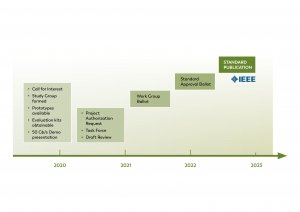IEEE 802.3 Standardization
The key development objectives for the new standard target outranging performance. The high speed will reach at least 25 Gb/s and will be scalable to 50 or 100 Gb/s. The temperatures range from -40 °C to 105 °C. Distances are 15 meters with 4 inline connectors for cars and 40 meters for cars and buses. Meeting OEM reliability requirements, the failure rate is below 10 FIT (Failures In Time: 1 FIT equals 1 failure per 1,000 devices operating 1 million hours).
Optical Multi-Gigabit Physical Layer for Automotive Applications
Complexity stays low with simple modulation. For fiber, the OM3 class is chosen, since it is already extensively used by data centers and avionics. Only extensively used light sources will be selected. Two connector grades are defined in order to allow cost-effective implementations. Regarding topology, asymmetric up and down links have been considered from the beginning. The use of the Energy-Efficient- Ethernet (EEE) specification is an appropriate candidate to implement this feature. Cameras, displays, and further asymmetrical use cases have been included as test cases for the standardization. An OAM side-channel will be available for dependability and link management. The absence of retransmissions means controlled latency for video distribution. Symmetric links will be added for backbone communications.
With cost-down and consistency in focus, optics, fibers, connectors, and electronics already developed for nGBASE-SR will be reused. Further specifications include 850 nm VCSEL, multimode OM3 fiber, PAM2 receivers, and connectors. Standardization work focuses on the automotive requirements: VCSEL reliability for the operation temperature range, connector development with quality grades, standardized wake-up and sleep protocols, and an adaptive DSP to cope with the large parametric deviation of the VCSEL. Increasing the yield percentage results in cost reduction.
Read on in the Whitepaper “Off-the-shelf System Solution – Optical Multi-Gigabit Connectivity in Vehicles“




